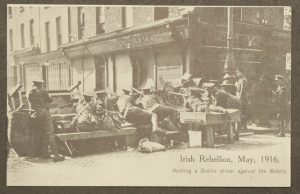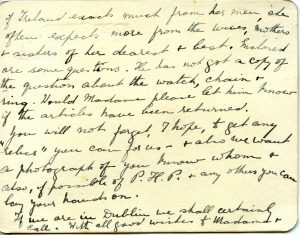Intended or not the 1916 Rising has been irrevocably associated with the Easter holidays, and so, we look back on the creation of the commemoration tradition, from its physical manifestation in 1916 to the informal ceremonial events of 1917. Originating from its immediate aftermath the Easter Rising has a host of associated memorabilia which was collected and cultivated by the Irish people. Quickly falling into the tradition of storytelling, the executed leaders of 1916 and the ill-fated combatants became a part of local legendary lore, along with previous figures like Brian Boru.

The collecting of memorabilia associated with the Easter Rising begins in the shadow of its aftermath. The production of commemorative souvenirs begins even before the executions of the Rising leaders have been completed. On the 11 May 1916 British soldier Tom Dolan sends two postcards exhibiting the damage caused to Dublin by the Easter Rising. To his sister he sends an image of a shelled Liberty Hall and asks for her opinion on the card itself.[1] For his father, he sends an image of the ravished General Post Office on Sackville Street.[2] Before long, there was an entire range of Easter Rising postcards being produced.[3]
The significance of these cards is evident in the dispute between Nora Casey and the local police in Kenmare, Co. Kerry. After displaying postcards depicting participants in the Easter Rising, such as Patrick Pearse and Countess Markievicz, local law enforcement instructed Miss Casey to remove them due to a military order prohibiting their exhibition. Miss Casey responds to the policeman by asking “if it is an order I suppose I must obey it, but how am I to sell the Photos if people don’t know I have them?”.[4] Later that evening Miss Casey returned the photographs to her window display and a dispute ensued between law enforcement and her lawyer. Subsequently, the military order is modified to allow the exhibition of such photographs, provided there were not accompanied “by S. F. [Sinn Féin] badges, crepe, or cards or documents containing “last words” of rebel leaders”.[5] Therefore, although contentious, these postcards were a popular commodity and rather face the backlash from an outright ban the military sought to regulate their display.

From the production of postcards to the collection of relics the trend of saving 1916 memorabilia progressed over the course of 1916. As the executions ceased, the trial of Roger Casement approached and internment continued public sympathies swayed and the support base for the actions of Easter week slowly began to grow. As a result people sought to associate themselves with the events of that fateful week through objects. On 9 June 1916 A. Guinnell writes to Nell Humphreys, the sister of ‘The’ O’Rahilly (1875-1916), to express sorrow for Nell’s poor sister-in-law, Nancy O’Rahilly. However, before signing off she requests that Nell send on any “relics” she can get, in addition to pictures of “you know whom”, Patrick Pearse and any others she may be able to find.[6] John Gibney’s A History of the Easter Rising in 50 Objects also demonstrates the desire to collect and maintain artefacts of the event. Included are objects, postcards, pictures and memorial cards. Containing images of memorial cards from 1917 and 1919 Gibney demonstrates the lasting impression of Easter week 1916 in the memory of the public. To this day similar ephemeral material can be purchased at auctions demonstrating that the legacy of the Rising still exists in physical form.[7]
While material culture was flourishing in post-Rising Ireland a number of participants in the event itself were still being detained in internment camps when the anniversary came. Detained away from home internees were forced to come up with their own way of marking the occasion. In Lewes prison they chose to mark the event with a memorial service for the Volunteers who had died in Easter week, as recorded by Paul Galligan, “those noble souls, the purest and best of Irish manhood and although we feel lonely and sad for such comrades yet we cannot regret them, they have led a noble life and died a glorious death”.[8] In Lewes they commemorated the event on the anniversary of Pearse’s surrender, in Dublin, however, a commemoration service was held on 9 April, Easter in 1917, as recalled by Helena Moloney.[9] The Irish Times recorded the event noting the gathering of crowds, the hoisting of flags on the General Post Office and incidents of stone throwing by Dublin “youths”.[10] For some the first anniversary was a call to action as previously quiet areas began to show support to the movement. Jerome Buckley of Mourne Abbey, Co. Cork, recalled that the Rising’s first anniversary was the first ‘happening’ in his area when he and other local youths flew tricolour flags from, “from two of the highest points in the district”.[11] Henry O’Keefe in Co. Waterford had a very similar experience, “Our first hint of defiance occurred at Easter, 1917, when we placed the Tricolour on tops of trees, chimneys of houses, and telegraph poles to celebrate the anniversary of the 1916 Rising.”[12]
While not an official celebration, or a quiet one, Easter 1917 marked the first year of commemoration for the Easter Rising. With a multitude of memorabilia and souvenirs around the country the tale of Easter Week 1916 became a popular one. Leading up to the first anniversary attitudes were changing and popular figures of the Rising were beginning to emerge and cultivate a story of their own. Official commemoration ceremonies would not take place until the formation of the Irish Free State several years later but, nonetheless, the first year mark did not go by unnoticed.
References:
[1] Postcard from Tom Dolan to Dolly Dolan, 11 May 1916. https://letters1916.ie/explore/letters/957.
[2] Postcard from Tom Dolan to his father, 11 May 1916. https://letters1916.ie/explore/letters/958.
[3] Collection of 1916 Rebellion Postcards. https://letters1916.ie/explore/letters/458.
[4] Letter from John P. Boland to Inspector General R.I.C., 11 July 1916. https://letters1916.ie/diyhistory/items/show/1957.
[5] Letter from Inspector General R.I.C. to John P. Boland, 21 July 1916. https://letters1916.ie/diyhistory/items/show/1956.
[6]Letter from A. Guinell to Mary Ellen O’Rahilly, 9 June 1916. https://letters1916.ie/explore/letters/1233.
[7] “Easter Rising 1916 artefacts go for auction at Whytes”, Irish Times, 4 November 2014. http://www.irishtimes.com/easter-rising-1916-artefacts-go-for-auction-at-whytes-1.1987576.
[8] Paul Galligan to Monsignor Eugene Galligan, 4 May 1917. http://www.theirishstory.com/2016/01/29/commemorating-the-easter-rising-part-i-1917-1934/#_ftn1.
[9] Helena Molony Witness Statement, BMH, p.42. http://www.bureauofmilitaryhistory.ie/reels/bmh/BMH.WS0391.pdf#page=1.
[10] “A Dublin Anniversary”, The Irish Times, 10 April 1917.
[11] Jerome Buckley Witness Statement, BMH, p.3. http://www.bureauofmilitaryhistory.ie/reels/bmh/BMH.WS1063.pdf#page=1.
[12]Henry O’Keefe, Witness Statement, BMH, p. 2.http://www.bureauofmilitaryhistory.ie/reels/bmh/BMH.WS1315.pdf#page=2.